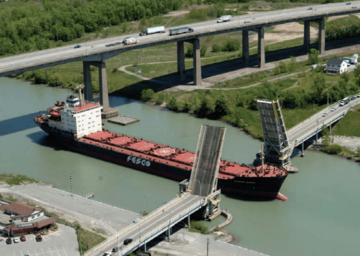List of canals in Canada facts for kids
Canals are like special waterways built by people. In Canada, there are many canals used for different important jobs. Some canals help bring water to cities, others help power stations make electricity, and many are used for ships to travel easily across the country.
Contents
Natural Canals
Sometimes, nature creates its own waterways that act like canals! One example is a natural channel between the Magaguadavic River and Lake Utopia near St. George, New Brunswick.
Shipping Canals
Shipping canals are built to help boats and ships move goods and people. They connect different lakes, rivers, or oceans, making travel shorter or helping ships get around obstacles like waterfalls.
Active Shipping Canals
These canals are still busy today, helping ships navigate across Canada.
- The Beauharnois Canal in Quebec is 24.5 kilometers (15 miles) long and has two locks. It helps ships travel between Lake Saint Francis and Lake Saint-Louis. This canal later became a key part of the larger Saint Lawrence Seaway.
- The Canso Canal in Nova Scotia is a short canal, only about 0.56 kilometers (0.35 miles) long, with one lock. It connects St. George's Bay to Chedabucto Bay. It opened in 1955.
- The Chambly Canal in Quebec is 20 kilometers (12 miles) long and has nine locks. It helps boats travel along the Richelieu River between Chambly and Saint-Jean-sur-Richelieu. It opened way back in 1843.
- The Lachine Canal in Quebec is 14.5 kilometers (9 miles) long with five locks. It connects the Saint Lawrence River at the Old Port of Montreal to Lake Saint-Louis. It was one of Canada's first major canals, opening in 1825.
- The Murray Canal in Ontario is 8 kilometers (5 miles) long. It connects the Bay of Quinte to Lake Ontario, providing a shortcut for boats. It opened in 1889.
- The Rideau Canal in Ontario is a very famous canal, stretching 202 kilometers (126 miles) with 47 locks! It connects the Ottawa River in Ottawa to Lake Ontario in Kingston. It opened in 1832 and is now a UNESCO World Heritage Site.
- The Saint Lawrence Seaway is a huge system of canals and locks that spans about 600 kilometers (373 miles) across Ontario and Quebec. It has 15 locks and allows large ships to travel from the Saint Lawrence River all the way to Lake Erie. It opened in 1959 and is vital for trade.
- The Sault Ste. Marie Canal in Ontario is a shorter canal, 1.6 kilometers (1 mile) long, with one lock. It helps ships bypass rapids on the St. Marys River. It opened in 1895.
- The Trent-Severn Waterway in Ontario is another long and important canal system, 386 kilometers (240 miles) long with 44 locks. It connects Georgian Bay (part of Lake Huron) to the Bay of Quinte (on Lake Ontario). It opened in 1833.
- The Welland Canal in Ontario is 43 kilometers (27 miles) long and has 8 locks. It allows ships to bypass Niagara Falls, connecting Lake Ontario to Lake Erie. It opened in 1829 and is also part of the Saint Lawrence Seaway.
Abandoned Shipping Canals
Some canals are no longer used for shipping, often because newer, bigger canals were built, or other ways of transport became more popular.
- The Baillie-Grohman Canal in British Columbia was a short canal, 1.5 kilometers (0.93 miles) long, connecting the Columbia River and Kootenay River. It was only active for a short time, from 1889 to 1902.
- The Newmarket Canal in Ontario was planned to be 16 kilometers (10 miles) long with three locks, connecting Lake Simcoe to the East Holland River. However, it was never finished.
- The Shubenacadie Canal in Nova Scotia was 114 kilometers (71 miles) long with one lock. It connected Halifax Harbour to Cobequid Bay. It operated from 1856 to 1871.
- The Soulanges Canal in Quebec had five locks and was used from 1899 until 1958. It was replaced by parts of the Saint Lawrence Seaway.
- The Welland Recreational Waterway in Ontario used to be part of the original Welland Canal. After a new bypass was built in the 1970s, this section became a recreational waterway where motorboats are not allowed.
Other Types of Canals
Not all canals are for shipping! Some have other important jobs.
- The Canal de l'Aqueduc in Quebec is an open-air aqueduct canal. It's used by the city of Montreal to bring drinking water to a pumping station in Pointe-Saint-Charles.
- The Kootenay Canal in British Columbia is a diversionary canal. It takes water from the Kootenay River and directs it to the Kootenay Canal hydroelectric plant, which uses the water to generate electricity.
- The Seton Canal in British Columbia also helps make electricity. It diverts water from Seton Lake to the Seton Powerhouse before the water flows into the Fraser River.


